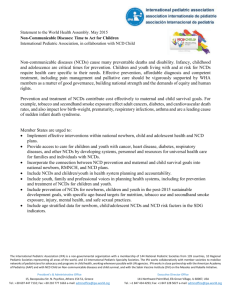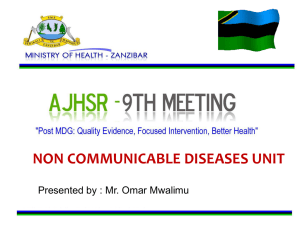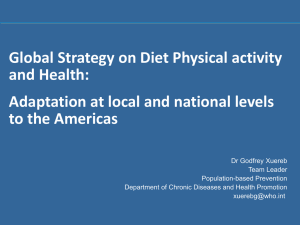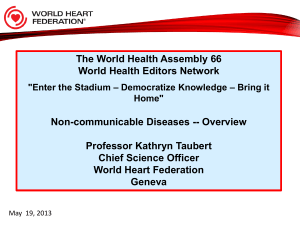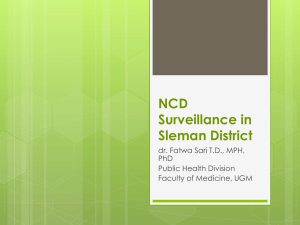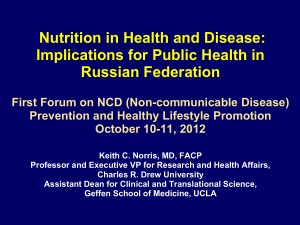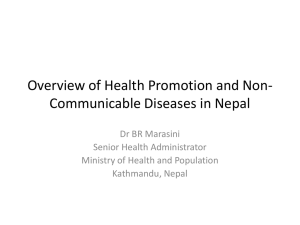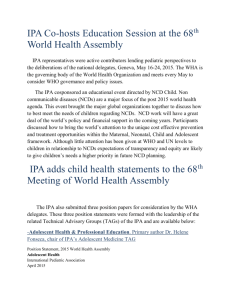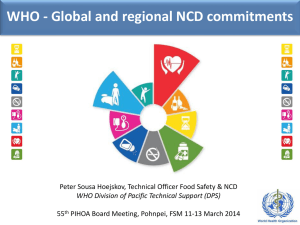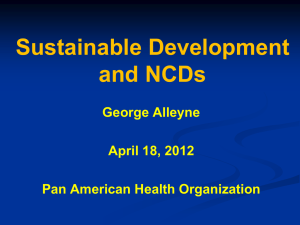Noncommunicable Diseases
advertisement
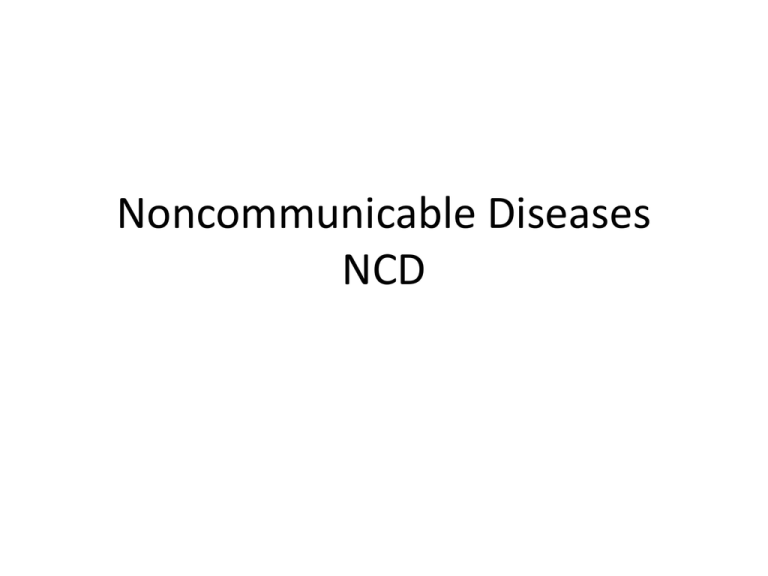
Noncommunicable Diseases NCD • Noncommunicable diseases (NCDs) kill more than 36 million people each year. • Nearly 80% of NCD deaths - 29 million - occur in low- and middle-income countries. • More than nine million of all deaths attributed to NCDs occur before the age of 60; – 90% of these "premature" deaths occurred in lowand middle-income countries. Annual Mortality Burden NCD 1. 2. 3. 4. Cardiovascular diseases deaths (17.3 million) Cancers (7.6 million) Respiratory diseases (4.2 million) Diabetes (1.3 million1). • Cardiovascular diseases, cancers, respiratory diseases, and diabetes account for ~80% of all NCD deaths. • Four shared modifiable risk factors: – tobacco use – physical inactivity – harmful use of alcohol – unhealthy diets. • Risk factors of tobacco use, physical inactivity, harmful use of alcohol, unhealthy diets lead to metabolic/physiological changes that increase the risk of NCDs: 1. 2. 3. 4. raised blood pressure Weight gain overweight/obesity hyperglycemia (high blood glucose levels) hyperlipidemia (high levels of fat in the blood). Modifiable Risk Factors • Tobacco accounts for almost 6 million deaths every year (including over 600,000 deaths from exposure to second-hand smoke), and is projected to increase to 8 million by 2030. • ~3.2 million deaths annually can be attributed to insufficient physical activity. • ~1.7 million deaths attributable to low fruit and vegetable consumption. • Half of the 2.3 million annual deaths from harmful drinking are from NCDs. Ranking NCD Risk Factors • 16.5% of global deaths are attributed to hypertension • Tobacco use (9% global deaths) • High blood glucose (6%) • Physical inactivity (6%) • Overweight and obesity (5%). – Low- and middle-income countries are witnessing the fastest rise in overweight young children. • The MDGs did not adequately address … increase in NCDs • Other significant NCD – mental and neuropsychiatric disorders – oral diseases – injuries – blindness WHO Response • First step – WHO, “2008-2013 Action plan of the global strategy for the prevention and control of noncommunicable diseases” • Includes measures/strategies to lessen the risk factors associated with NCDs. • Plan has 6 objectives…. 6 Objectives 2008-2013 NCD Plan 1. To raise the priority accorded to NCD in development work at global and national levels, and to integrate prevention and control of such diseases into policies across all government departments. 2. To establish and strengthen national policies and plans for the prevention and control of NCD. 6 Objectives 2008-2013 NCD Plan 3. To promote interventions to reduce the main shared modifiable risk factors for NCD : tobacco use, unhealthy diets, physical inactivity and harmful use of alcohol 4. To promote research for the prevention and control of NCD. 6 Objectives 2008-2013 NCD Plan 5. To promote partnerships for the prevention and control of NCD. • 6. To monitor NCD and their determinants and evaluate progress at the national, regional and global levels NCD Goal Setting • May 2012 World Health Assembly approved the goal to reduce premature deaths from NCDs by 25 percent by 2025. • Video • http://www.prb.org/Publications/Datasheets/ 2012/world-population-data-sheet/video.aspx Global NCD Action Plan 2013-2020 • WHO member States set the first-ever voluntary global targets to prevent and manage NCDs, 11/12 • WHO approved a comprehensive global monitoring framework for the prevention and control of NCDs, including a set of indicators and a set of voluntary global targets, 5/13. Global NCD Action Plan 2013-2020. Global NCD Action Plan 2013-2020. • Sets 9 voluntary global targets and 25 indicators aimed at monitoring progress in reducing the burden of NCDs, cutting risk behaviors, and monitoring multisectoral action and health systems responses to prevent and manage NCDs. Voluntary Global Targets Aim to: • Cut avoidable premature deaths from the leading NCDs by 25 percent • Decrease leading risk behaviors, namely tobacco use, harmful alcohol use, physical inactivity, and excess salt/sodium intake • Stop the rise in diabetes and obesity and reduce population levels of raised blood pressure • Encourage access to essential medicines and technologies for NCDs and promote appropriate use of drug therapy to reduce heart attacks and strokes Selected Benchmarks (1) A 25% relative reduction in risk of premature mortality from cardiovascular diseases, cancer, diabetes, or chronic respiratory diseases (2) At least 10% relative reduction in the harmful use of alcohol, as appropriate, within the national context (3) A 10% relative reduction in prevalence of insufficient physical activity Benchmarks (4) A 30% relative reduction in mean population intake of salt/sodium (5) A 30% relative reduction in prevalence of current tobacco use in persons aged 15+ years Benchmarks (6) A 25% relative reduction in the prevalence of raised blood pressure or contain the prevalence of raised blood pressure, according to national circumstances (7) Halt the rise in diabetes and obesity Benchmarks (8) At least 50% of eligible people receive drug therapy and counseling (including glycemic control) to prevent heart attacks and strokes (9) An 80% availability of the affordable basic technologies and essential medicines, including generics, required to treat major NCD in both public and private facilities • The Problem • Cooking and heating with solid fuels indoors pollutes the air and increases the risk of illness for nearly 3 billion people worldwide. This type of indoor air pollution is the leading cause of lung cancer and chronic lung disease among nonsmoking women in the world’s poorest communities. The risk for cardiovascular diseases, digestive and cervical cancers, and low birth weight babies may increase when women breathe this unsafe air every day.

